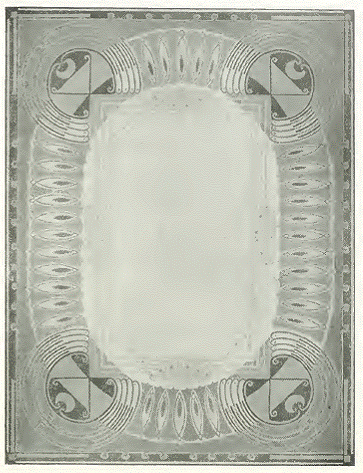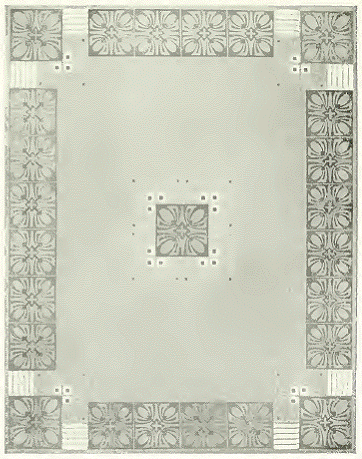Illustration: Peter Behrens. Rug design, c1902.
The German Peter Behrens is often thought of as a seminal architect and industrial designer who played an important role in the rationalisation of design and decoration. Behrens was an influential figure as regards Modernism and has his place in the pantheon of twentieth century modernisers. However, Behrens also produced work in disciplines that were not always immediately associated with rational Modernism, such as ceramics, glass and textiles.
The three rug designs illustrated in this article were produced by Behrens in the first few years of the twentieth century and may well have been designed when he was still a resident of the Darmstadter Kunstlerkolonie (Darmstadt Art Colony). It is here that the artist and designer built his first house and therefore added architect to his rapidly burgeoning cv. It is said that the building of the Behrens house at Darmstadt, helped to galvanise the designers' ideas concerning a rational approach to design and helped to move him away from the Jugendstil styling that was still so much a part of fashionable German design and decoration.
Illustration: Peter Behrens. Rug design, c1904.
Behrens house was deliberately conceived as a gesamtkunstwerk, a total work of art. Therefore, everything both inside and outside of Behrens house was coordinated and balanced so that there was a sense of harmony throughout the house. Gesamtkunstwerk became an important element within interior design and decoration, though the ideal of a total work of art was by no means limited to interiors and the phrase was often used for a number of creative ideas and events, particularly within German nineteenth century staged opera. The ideal was that of an event that incorporated all of the creative arts within one significant project. However, as far as interiors were concerned gesamtkunstwerk concerned itself with the integration of architecture, design and decoration, very often under the exclusive guidance of one individual, usually an architect. This idea gained in both momentum and importance the nearer the era came to the twentieth century and gesamtkunstwerk projects could be found across Europe and North America and included such architects and designers as Josef Hoffmann, Charles Rennie Mackintosh and Frank Lloyd Wright. Behrens himself coordinated furniture, ceramics, glass and textiles within his Darmstadt home and so therefore the three rug design examples shown here, although not necessarily total art works in their own right, should be considered as examples that may well have been influenced by the idealism of gesamtkunstwerk.
The three rug examples, one square and two rectangular, are extremely structured and relatively minimal, at least as far as decorative flourish is concerned. However, all of the examples appear as harmoniously balanced decorative projects. It is a mistake to think that because a design is symmetrical, controlled and stable, that it somehow lacks both the dynamism and creative life of a deliberately asymmetrical and casual approach. Behrens design work is a fascinating glimpse of work produced just a few years before he was involved in the foundation of the Deutscher Werkbund along with the likes of fellow German designers such as Richard Riemerschmid, Bruno Paul and Josef Maria Olbrich. The Werkbund became one of the most important foundation stones of the twentieth century's Modernist movement, and represented a fundamental shift in both the relationship between designer and manufacturer, which had often been problematic, and the adoption of a rationalist approach to design across many disciplines both industrial and interior.
Illustration: Peter Behrens. Rug design, c1904.
Behrens rug examples from this period, along with those of a number of his contemporaries, gives an indication of where the general consensus regarding design and decoration was truly leading, at least initially in Germany, and later in the rest of Europe. It is often misleading to see Modernism and its relationship with industry, as being an enemy to self-expression in the decorative arts and crafts. While mass-production has destroyed much of the hand craft industry, this was started long before the idea of Modernism emerged. If we were to be brutally truthful, hand production was not always as inspiring and creative as we would like to believe. While the work itself was often above the standard of that produced by mass production methods, the design and pattern work could often be both derivative and lacking in any form of creativity lacking any compositional balance or harmony. In this respect Behrens rug design work should be seen as a sensitive, intelligent and above all individual addition to the Modernist approach. While many in the Modernist movement idealised the machine and its role in contemporary life, others were more circumspect concerning the propensity of the machine to dominate and solve, and valued the human role of individual creativity and felt that design and decoration would be the poorer without the dynamism that that entailed.
The struggle between finding a fruitful and creative balance between machine and human creativity has continued to this day and will probably continue for some time to come. There is no definite answer and although there have been many iniatives over much of the twentieth century and into our own, none of these really addresses the problem of finding a harmony between the two often conflicting systems. We are left with either complete capitulation or open hostility.
Reference links:
Peter Behrens and a New Architecture for the Twentieth Century
Industriekultur: Peter Behrens and the AEG, 1907-1914
Peter Behrens: Architect and Designer
Peter Behrens in Duesseldorf: Die Jahre Von 1903 Bis 1907 (German Edition)
Design of the 20th Century (TASCHEN Icons Series)
German Design for Modern Living
Steel and Stone: Constructive Concepts by Peter Behrens and Mies van der Rohe
German Industrial Designers: Luigi Colani, Ferdinand Alexander Porsche, Peter Behrens, Marianne Brandt, Ingo Maurer, Dieter Rams



